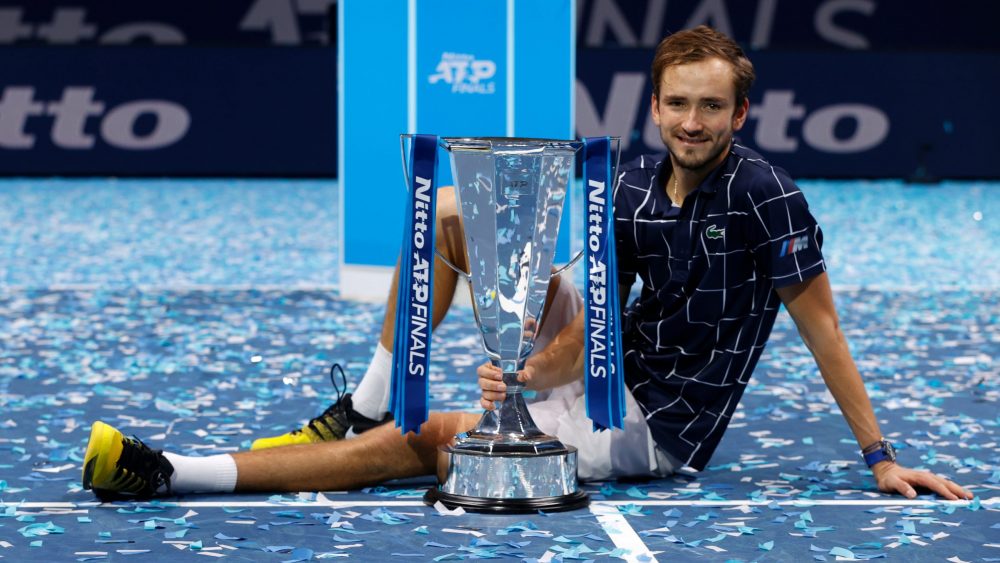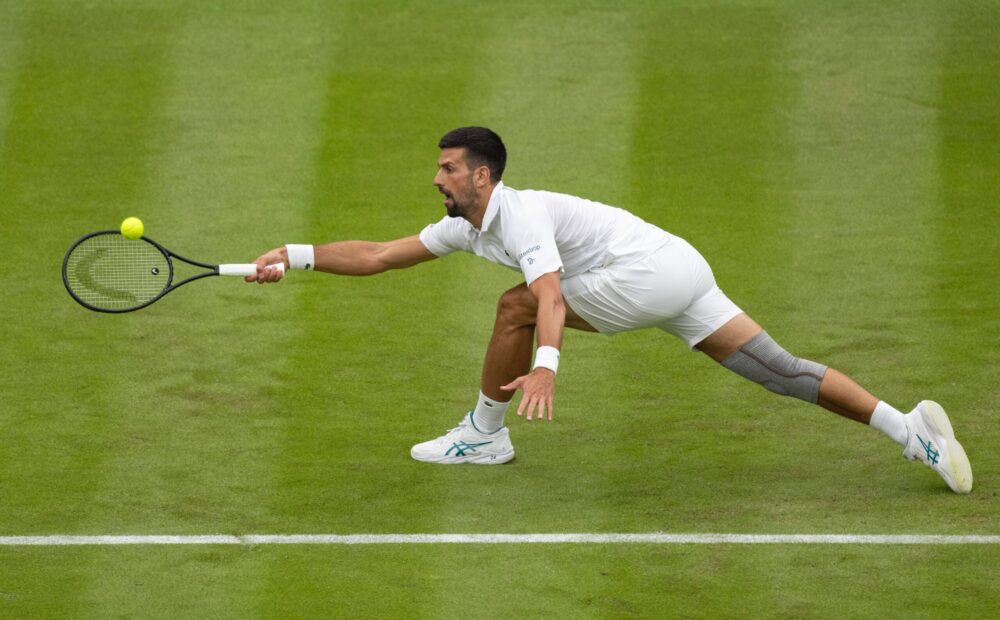The 12-edition-long O2 residency of the ATP Finals ended as it began, with a Russian winner. Daniil Medvedev didn’t even know this was the case, but it was Davydenko himself, now a pundit for a Russian TV channel, who informed him during the post-match interview. Davydenko beat Del Potro 6-3 6-4 in the final after vanquishing his worst nightmare Federer 7-5 in the decider; in the round robin, he lost (7-5 in the decider as well) against Djokovic while defeating Nadal (6-1 7-6) and Soderling (7-6 4-6 6-3). While his victory was quite the surprise at the time, Medvedev’s really wasn’t, because he had already played lights-out tennis in Paris. Now 24 years old, Daniil is no doubt worthy of this title for several reasons.
1) He was undefeated in November, winning 10 matches in a row between Bercy and London, including seven against five different Top 10 opponents (he beat Zverev and Schwartzman twice). He ended up notching 2,500 points and winning the ATP Finals without a single defeat, and put in the effort even against Schwartzman, an adversary he played after already securing the top spot in his group – the Argentine was the weakest player in the draw, but Medvedev could have still decided to save some energies for his semifinal encounter with Nadal.
2) The fact that he won the crown as an undefeated champion gains even more significance when we look at the history of the event: the winner lost one match throughout the competition a whopping 25 times (out of 47, because the tournament has taken place 51 times but four of these had no round robin, so the champion had to be undefeated by definition). That’s more than 50 percent of the time, including nine out of ten in the 1990s – Sampras won the tournament five times and always lost a bout.
3) Medvedev is the first ever to win the ATP Finals while defeating the best three players in the world (Djokovic in the group stage, Nadal in the semis and Thiem in the final) on route to success.
4) As for other events, only three times in history had a player ousted the Top 3 in the same tournament – Becker in Stockholm in 1994, Djokovic in Montreal in 2007, and Nalbandian in Madrid later the same year. However, none of them had done it in a tournament as important as the ATP Finals, and no one has ever done it in a Major.
5) Medvedev didn’t lose a set in the group stage, but came from behind in both his knockout matches, another feat that speaks volumes of the value of his success. Nadal even served for the match against him at 5-4 in the second set, but the Russian broke him to love and never let up from then on. Against Thiem, he saved three break points in the second set, but was always on the front foot in the decider. He led 0-30 in the opening game, had three break points in the third and two more in the fifth before finally breaking through on the eighth total occasion – he had wasted a chance in each of the previous sets.
6) He proved how complete his game is. Despite not being very graceful, he has an effortless style, and moves amazingly well for a 6-foot-6 guy: he has outstanding knee flexibility and can run for hours without wearing himself out, never losing the ability to push those unorthodox groundstrokes (especially the forehand, with a very wide backswing and quite frankly unappealing to watch) deep down the court. Medvedev outlasted both Nadal and Thiem in the respective deciders, and while the advanced age of the Spaniard is an understandable factor in such situations, Thiem’s struggles probably owe to the grueling match he played against Djokovic – he faced the Serbian before Medvedev beat Nadal, but in all likelihood wasted more resources.
7) He led the eight participants in most serving stats, netting more aces, putting more first serves in play and winning more points than anybody else with his second serve. It’s quite the headstart to be able to win so many free points when your main competition has to toil far more to get on the scoreboard. When I say that Medvedev is a complete player (despite his clay-court limitations), I think of the variety of his shots. He can approach the net, often sneaking in the most unexpected situations, such as behind a second serve. He can trade sliced backhands with Nadal and Thiem – he actually outperformed Rafa with the shot, and, while less successful against the US Open champion, he still held his own. He can mix up the speed and net clearance of his groundstrokes like Mecir and Murray did, and he can flatten his shots either crosscourt or down the line.
8) He is most certainly a clever player, both on the court and outside of it.
The Austrian shanked three break points in the second set, and one in particular must have stuck in his memory: Medvedev serve-and-volleyed and barely put a drop volley over the net, but Thiem, despite getting on the ball with ease, put wide a forehand that he could have made. Thiem tried to play with a clear strategy but didn’t have the acumen to change it when things started to go south, something that is never easy to do. I asked this question to the world No.3 in the post-match press conference, although I’m aware that he is more powerful than Medvedev but not as eclectic.
My question was: “Do you regret playing so many sliced backhands?” He didn’t think that was a mistake, though: “I will do the same thing in our next encounter, it’s what I did in all of our previous matches.” Of course, that was a decision he had taken together with his coach, Nicolas Massù, and it seemed to work in the opening two sets, but I think that he should have tried something different at the tail-end of the match, because that particular shot had become very predictable and wasn’t fetching him any more points. It’s the same thing that happened to Nadal on Saturday, a tactical choice that didn’t seem to bother Medvedev: “Nadal probably won just a couple of points with the slice, it didn’t really affect me.”
There is no proof that things would have turned out differently with a different game-plan. However, my impression is that Medvedev realised that Thiem was trying to break his rhythm and adjusted by patiently slicing the ball as well and waiting for the best time to sneak to the net, where he won 28 points out of 37. In the end, Thiem went against his own nature, retreating into a conservative tactic in lieu of detonating one-handers like the one that gave him a double match point in the third set’s tie-breaker against Djokovic. Overthinking is a demanding process and can become costly when a match goes the distance.
Former Top 15 player Paolo Bertolucci kept calling for greater tactical variety when Medvedev had clearly adapted to the Austrian’s game, but he forgot to add how hard it is to alternate between slice and topspin backhands. After hitting five, six sliced shots, it is very hard to suddenly switch grips for a flat or topspin winner without losing control – as a matter of fact, Thiem tried to do so and the unforced error tally started to grow, and not just on that wing, but also on the forehand side, perhaps because the alternance between grips and ball distances was making him uncomfortable.
The fact is that Thiem was glued to the baseline, while Medvedev did it all, standing far behind the baseline, slicing and flattening his shots, following his serve to the net and even throwing in some chip-and-charge on his opponent’s serve. When he comes to the net, it’s not easy to pass him, because he’s really tall, and his touch is good. While it’s true that Thiem’s tactics worked in the past against the Russian, this line of reasoning doesn’t take into consideration the improvements that Medvedev might have undergone. I’ll stop here, because I don’t want to be thought of as an arrogant journalist who thinks he knows more than an Olympic champion like Massù, who evidently told his player to stick to his guns no matter what.
I’d like to add that I’m happy about the level of play in the knockout phase. Nadal vs Thiem in the group stage was also a good match, but the semis and the final were more vibrant and more open till the end. The three matches were decided by very fine details and circumstances, and they could have gone either way. This is why I think that Nadal, Thiem and Djokovic should be lauded as much as the champion, although this is something that seldom happens in sports. I wish I was there, but I enjoyed myself even though I had to watch on TV, and I hope that our readers can say the same thing.
During these wretched times, those who could afford it could watch some pretty good tennis in New York (where the final, while not beautiful by any means, was still a nail-biter), Rome, Paris and London. Let’s not forget that, up until three weeks before the Cincinnati-New York tournament began, we still had no certainty whether the season would have resumed in 2020 or not.
I don’t know what will happen with the Australian Open, nobody does, but I hope that the Covid nightmare will be over by the time of the first Turin ATP Finals at the latest, although there is really no way to know how long we will have to keep wearing masks.
NOTE: Article translated by Tommaso Villa

 Hot Topics3 days ago
Hot Topics3 days ago
 Latest news3 days ago
Latest news3 days ago
 Hot Topics2 days ago
Hot Topics2 days ago
 Hot Topics3 days ago
Hot Topics3 days ago
 Focus2 days ago
Focus2 days ago
 Focus2 days ago
Focus2 days ago
 Focus2 days ago
Focus2 days ago
 Hot Topics2 days ago
Hot Topics2 days ago





























